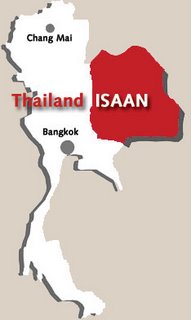
Hello all,
It’s about time I sat down and wrote a decent story about my recent trip last October, after piddling around for so long.
My trip was to Isaan, which is what the people of Thailand call the Northeastern area of Thailand. It was my first visit to meet Mam’s family, besides talking to them on the phone, and I was a little insecure about what to expect.
Although I had never traveled anywhere in Asia by train before, purchasing the tickets turned out to be an easy process and the full cost was an affordable 8000 baht for a round trip ticket in a first class berth. First class consists of a small room with a bench type cushioned seat, table, window, sink, air-conditioner and area to stow your belongings. In the evening, a steward comes by to turn the cushioned seat into a rather comfortable upper and lower berth.
I was somehow lucky and ended up with the lower berth all the way to Bangkok and again to Khon Kaen. Naturally, unless you purchase the remaining berth also, for privacy, you will end up getting a bunkmate (of the same sex).
I rode with a rather pleasant Chinese / Thai gentleman and his daughter to Bangkok, and had a Frenchman for a bunkmate on my trip to Khon Kaen.
The Chinese / Thai guy was interesting, but spoke little English. As it turned out, he was from Yala, which is one of the three hotspots for violent Muslim insurgence in the deep restive south. Although I live in the south, I am quite a ways from Yala, Narathiwat, and Pattani, where people are shot and killed on a daily basis.
My bunkmate spoke to his wife several times on his mobile phone during the trip, and I caught bits and pieces of Mandarin, which is still a bit familiar to me, which told me he is from Chinese origin. I ate a light dinner and snacked on some roasted cashews cooked with chili peppers while reading the Bangkok Post newspaper, and hit the sack early.
In the morning, my bunkmate was on the phone with his wife again and although I couldn’t understand him, I know he was joking around with her about having me as a bunkmate, because he lowered his voice and laughed. No doubt he was telling her that I snored terribly, which I do. His cute little daughter and I got along pretty well during the trip, as I get along with most young kids.
I arrived in Bangkok at around 10:00 a.m. and was quite taken back by the huge train station. Besides tons of people, it was surprisingly clean and well guarded. You wouldn’t have to go far to find a cop in that place. The central building is massive and filled along the sides and balconies with a deli, bakery, a jewelry shop (where I bought Mam a gold bracelet), coffee shop, clothing shops, a massage parlor (no shit), bookstore, German sausage deli, food court and a couple of restaurants. Although I think I slept pretty well, I was a bit frazzled and naturally headed right for one of the restaurants up on the balcony, after checking my bags into the luggage check. Armed with a newly purchased Bangkok Post newspaper and Michael Crichton novel, I settled into my lounge chair and began to feel like a seasoned traveler. Traveling alone is an enriching experience, I think, because you are alone with just your thoughts and can just soak up all the experience, rather than engaging in monotonous conversation.
I ordered some Vietnamese egg rolls, a papaya salad and a drink and sit back to watch the going’s on below.
Nothing like sitting in a comfortable atmosphere, eating good food and doing some people watching. And man, Bangkok’s Hua Lamphong train station is certainly a good place to start! People from every walk of life imaginable come prancing through that station. Muslims, Buddhists, Taoists, Hindus, Monks, Sherpas, Chinese, Nepalese, French, English, American, Tibetan, South American, Malaysian, Singaporean, Taiwanese, Canadian, Central American, Brazilian…you name it.
The “people watching” spectacle for today, was a fairly tall, provocatively dressed Asian woman, dressed in a tight fitting, almost florescent lime green dress, and strutting about in at least eight to ten-inch high platform heels, who definitely did not have an agenda to display…meaning she was cruising for men. In the high profile area of the train station, she stood out like a turd in a fishbowl, but nonetheless, she was a delight to observe.
My layover in Bangkok was about ten hours, so I settled in to occupy my time as best as I could, without getting bored in the process. I eventually ordered some food and ended up munching on things left and right my whole time there. I bought a phone card and after many frustrating minutes, managed to call Mam in Chum Phae around 6:00 p.m. and tell her I was okay and in Bangkok and on my way. She squealed with delight, which really boosted my confidence in meeting her.
I saw some really interesting people while I was in that train station and ended up chatting with a guy from Hong Kong, whose English was as good as mine. He was reading a book that was entirely in Chinese and listening to some Mp3’s of some awesome hard house and trance music that I envied. Just before my train arrived, I struck up a conversation with a Thai guy from Bangkok who was traveling on to Nong Khai, on the border of Cambodia to the north of Chum Phae.
Once settled into my berth on the northbound train, I awaited my bunkmate…who will it be this time? Will they speak English? As it turned out, it was the Frenchman. Unfortunately I forget his name, but we had a pretty good time together. He was wicked tall and wore glasses. His huge backpack barely fit into the berth, but we managed to arrange things where we were comfortable. His English was pretty good but his accent was thick and I occasionally either just nodded, or had to ask him what the heck he was trying to say. As it turned out, he was on an extended holiday and was just traveling on a lark, to wherever he decided to go, whenever he wanted, which I thought was pretty cool. He was also headed to Nong Khai, and was planning to enter Cambodia from there.
During the evening hours on the train, a steward always comes by carrying a list of the food, snacks and drink offered on the train. They also take your order for breakfast in the morning. After my experience riding from Hatyai to Bangkok, I learned quickly that stuff offered on the train was wicked expensive, so I had packed my backpack full of drinks, a couple of hot German sausage sandwiches from the German deli, and a KFC chicken sandwich. Needless to say the French guy was a bit envious of me, after he paid his bill for the evening meal and discovered his food was only moderately palatable.
The French guy and I chatted late into the night, watching the dimly lit train stations pass by, as we forged on into the night.
I finally managed to fall asleep, but knowing that my destination was but a blip in the track, I slept with one eye open. My travel alarm woke me at 4:00 a.m. and I ambled out of my bunk and into the “western” bathroom. There are two bathrooms on each train car. One is a “western” one, equipped with a western style toilet (like you know and love) and an “eastern” one, equipped with a squat toilet. If you don’t know what a squat toilet is, or have never seen one, you really should do yourself a favor and Google search one. Suffice it to say that Asian people are used to “squatting” whereas westerners “sit.”
Both bathrooms on the train car are equipped with a shower water head, so you can take a shower. You enter, lock the door, disrobe, and turn on the shower. Simple, right? Ha! Just add to the equation a tiny room, a moving train, and freezing cold water. Fun! Fun! Fun!
Once showered, I returned to our berth and quietly dressed. By 4:30 a.m. I was ready to go. At 4:40 a.m. my coffee arrived and I barely had time to suck it down before the steward told me to get ready for my departure. Frenchy managed to get his sorry ass out of bed to film the whole event of my leaving, but everything happened too quickly for me to tell him to send me a copy of the CD. Suddenly we were pulling into Khon Kaen station and I was being quickly ushered off the train.
----------------------------------------------------
Imagine getting off a train at 4:30 in the morning, carrying a heavy backpack and side bag, with little sleep, onto a train platform out in the middle of nowhere, in Northeast Thailand, trying to prepare yourself physically and mentally, to meet a woman and her family, whom you are planning on spending the rest of your life with, but barely know…
Okay, got it?
Yeah, right.
I began to amble slowly towards the train station, from the platform, as the train pulled away. I hiked up my backpack, adjusted the straps and strained my eyes into the distance to see if I could see anyone waiting for me.
My train car was one of the last ones, so I was a considerable distance from the train station once I disembarked. I walked slowly to gather my thoughts, wondering how to act, wondering what to say, what to do…
After what seemed like eons of walking, but was actually only minutes, I caught sight of a group of people to my right, near the train station, who were craning their necks to see the arriving passengers (of which there was only one…me). I stared at them hard, straining to see Mam and easily caught sight of her, just before she broke away from the group and came running to me.
We embraced and kissed, her all giggles and me a haggard, yet smiling, lump. Suddenly the group of people on the platform surrounded us, and my bags were snatched away. Our entourage began to move towards the train station, and I just remember a feeling of confusion, but allowing myself to let go and allowing these good people to take charge of my possessions and me.
On the train platform, I noticed a rather sexy, provocatively dressed woman standing there, watching the entire going’s on and thought to myself (we men never change, do we?) hum…I’d like to “do” that! Well, as it turned out, that “woman” was in fact a man, lady boy, or katoey’s as they call them here in Thailand and he / she was the driver of our transportation to Chum Phae. Noi, the katoey, (hey that rhymes!) sat next to Yao, her / his ummm…husband. Yep, the lady boy was married to this guy and as it turned out, she had two husbands!
Strange goings on happen in the flat lands of Isaan I’ll tell ya…
Mam and I sat in the little rumble seat in the back and Boot (a humorous distant relative) and Paan (Noi’s mother) rode in the back of the truck. The trip from Khon Kaen was a long one, taking a little over an hour and in that hour I learned a handful of Thai, to add to my already dwindling repertoire. I thought to myself, “This is going to be a very interesting vacation!”
Mam was dressed in her jeans and a nice blouse. She looked pretty and was very affectionate to me, which really cut through all my nervousness and anxiety. As it turned out, her English had improved, and her main difficulty speaking to me was just that she had a bit of difficulty adjusting to my accent. Thai’s typically learn English through television programs, other Thai people, or other foreigners, and Mam had learned all of her English through all of the above channels and two German and Swiss men who assisted her on weekends. So, my voice was pretty odd to her.
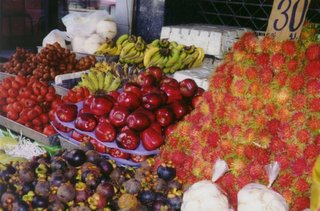
We finally arrived in Chum Phae and promptly found the local market, which by Thai standards, is huge. I wanted to pick up some fruit as a friendly offering to her parents, when I arrived, which is a standard thing to do when you’re visiting someone, and an offering which is well received.
We purchased an enormous amount of fruit that day, bringing home apples, bananas, longan, dragon fruit, rambutan, mangosteen, pommelo, and other local delights that quite literally filled the bed of the truck, but which ended up quickly disappearing in two days. In the village, everybody knows everybody and when somebody “scores” a good amount of chow, people tend to come out of the woodwork to visit and eat. The town of Chum Phae, as it turned out, is a bit far removed from Mam’s actual village, which is called “Wang Hu Gwang.”
Despite what I’d read about Isaan, Mam’s village wasn’t as “poor” as I’d expected, but that is certainly relative since I’ve traveled quite extensively in Asia and have lived here for nearly three years now. I’m sure if I snapped my fingers and plucked any of you from your comfortable homes in the West, and plopped you down into Wang Hu Gwang, you’d want to help those poor villagers in some way.
Lifestyle in the village can only be described as rich. Not “rich” in a monetary sense, but in a social and cultural sense. Things are different in Asia, as it’s a collectivist society, whereas we in the West come from an autonomous society and tend to keep to ourselves. Privacy is not a tangible concept in Thai society, especially in the villages of the Northeast. Everybody helps everybody and people come and go into others homes as if it were one big home, rather than a village.
Once I arrived at Mam’s house, her mother literally ran to me and hugged me, which was quite a unique experience and definitely welcoming. Her father, on the other hand, is a very reserved, quiet individual who is considered by most to be quite the oddball. He is reclusive at best, choosing not to live at home with his wife and children, but rather to live on his farm, which consists of about 13 Rai of land (about five acres), way out in the boonies. He nodded to me when I offered him my best wai, which is the standard respectful Thai greeting placing the hands together as in prayer, and holding them in front of your face while bowing your head. I then extended my hand to shake his, to try and cover all bases, and clumsily banged my head on the low hanging straw roof of their Kleh, which is a small bamboo platform raised off the ground, for eating and napping, covered by a straw thatched roof.
He smiled and asked in Thai, “How tall is he?” Then everybody laughed, which seemed to break the ice a bit. Things were a bit uncomfortable at best, for a while, since nobody but Mam spoke any English at all, save for “Hallo” and “Bye bye.” So I just sat there in silence, smiled a lot, and watched everybody’s antics. Inside of an hour, half the village was at Mam’s house to try and sneak a glance of the Farang, or Westerner. My popularity was just this side of Hollywood stardom, since I was the love interest of one of their coveted and widely popular villagers. This was novel at first, but ended up being a pain in the ass later in the week.
The communication issue wasn’t so bad really, between Mam and I, except for the fact that her plans were never communicated to me and we often would just “pick up and go” seemingly at a whim, without my knowledge of what was happening. We visited Panukhao, a strip of local mountains that take an interesting and odd shape, and which contained a rather large camping park. This was an interesting venture, since the water running from a local waterfall and coursing through the park, was actually clean. The kids had a blast swimming in the water, as we adults sat around the picnic tables scattered about and placed our orders with the local “waiters” who wandered from site to site with little notepads, taking food, drink, and snack orders and delivering them to your site.
We ate some terrific barbecued sea bass, with piles of vegetables and hot chilies on top, some barbecued chicken on a stick and other little Thai tidbits, which caused me to walk away, fanning my mouth, which was burning like fire.
Mam’s family prepared food on a daily basis, but there was a definite delineation between the food that was prepared for me and “their” food. Mam seemed to inherently know that their “Isaan” food would be semi-lethal to me, if not totally disgusting, so she kept an eye on me and would scold me if I got close to sampling their victuals. She needn’t worry, as I rarely could get the stuff past my nose. Isaan food, as she affectionately calls it, is often a mixture of pungent, often fishy smelling goop, most of which is mixed with the leaves and greenery of local plants, trees and flowers. Strong curries, pasty ground up fish, screaming hot Thai chilies, and noxious, strange vegetables are mixed into a bowl, some cooked, some not cooked, and sampled by reaching into a wicker basket full of sticky rice, grabbing a small handful and rolling it into a ball, which is then dipped into the bowls of noxious Isaan food and eaten.
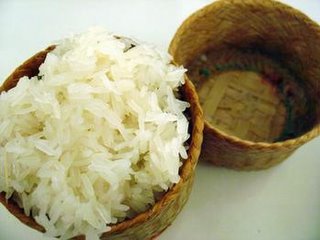
Everywhere you go in the village, you’ll see Thai’s walking about, toting their round little wicker baskets of sticky rice on a string. They stop in to visit local neighbors and…whoosh! Out comes the food or fruit and off comes the top of the wicker basket, exposing the sticky rice (and I do mean sticky), for all to enjoy. Rice as you know it, and perhaps love, is totally different than sticky rice. If you visit a local market in Asia, you’ll see large 50-kilo bags of rice out on display, with various price tags stuck into the rice. Sticky rice, upon closer inspection, is decidedly different in size, shape and color, than the other varieties of rice on display and decidedly cheaper. It is a staple in Isaan and often the only thing a family may eat during times when they have little or no food or money.

Sticky rice is prepared in a rather complicated way, cooked the conventional way rice is normally cooked, then steamed in a large wicker basket over hot coals or an open fire. It is then kneaded and packed into the smaller, portable wicker baskets that the local Thai’s tote around everywhere with them.
The poverty in Mam’s village is present, but in the Thai collectivist society of Wang Hu Gwang and other local villages, you can’t really see it unless you actually get to know the people. Spending weeks upon weeks living on sticky rice, locally picked greens from the leaves of trees and plants, and water, is commonplace to them and it’s really a humbling experience to behold. The contrast is the fact that Thai men seem to always find means to purchase their Thai whiskey and beer, while often their family ends up scrounging for food.
Looking back at my life in the U.S., I’m often ashamed at the waste I grew up taking for granted. Now, I fully understand why my mother and father always insisted I clean my plate when I was young, as they had spent seventeen years living in Asia.
On any given day, someone rides by on a motorcycle equipped with an umbrella, small food stand and barbecue, and offers locally cooked delights such as hot buttered corn, marinated hard boiled eggs, or other Thai foods to people who have some spare change to spend. I often contributed to these hawkers, enjoying the wide variety of tastes of local food. On one particular occasion, Mam was hankering for some Som Tum, a spicy papaya salad that is widely popular around Thailand, and I purchased some. Mam gobbled it up, while grinning from ear to ear at me, while I fanned my mouth, which, yet again, was on fire.
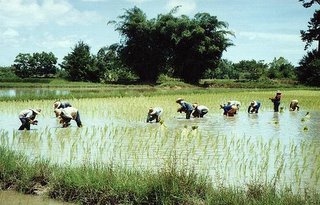
We made two trips to the market in Chum Phae, to buy food provisions for the family. I always looked forward to these trips, since in my opinion, one hasn’t lived until one has shopped at an Asian wet market. The sights, sounds, smells and feel of an Asian market are often offensive, but always excite me. Mam’s family was appreciative to say the least, since they were going through one of those aforementioned “poverty” periods, living on sticky rice, locally picked victuals, and water. The reason the family had little or no money, was Mam’s father had not harvested his rice yet and money was not coming in on a regular basis. Small amounts of income came available from time to time, when Mam’s mother would sell one of her homemade Patun’s, which is a colorful, wraparound skirt widely worn by local women, and fashioned on her homemade loom. Other sources of occasional income were homemade candies wrapped in banana leaf and other homemade treats.
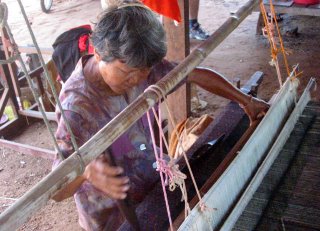
I often watched Mam’s mother as she spun thread onto spindles using an old bicycle wheel and wooden contraption made from scrap pieces of wood, and her hours spent on her loom, piecing together a beautiful patun from locally purchased thread. It was amazing to watch and her patience amazed me. I asked Mam if she knew how to make these beautiful skirts and she simply frowned and said, “My mother want to teach me, but I no want to learn. I don’t like.” Fully understandable, I retorted, as for the life of me, I couldn’t see how anyone would have the patience to piece together a patun, some of which are very elaborate and take months to piece together.
One day her mother took off on her bike to visit the market and returned with some coconuts, some green tapioca granules, sugar, peanuts and other interesting but undistinguishable items. Magically, some of the local women seemed to come out of the woodwork to help with her project of piecing together a candy concoction. I helped by watching as Mam toted a huge, dangerous looking knife and deftly hacked the coconuts in half. Then, I took my turn. Although I wasn’t as experienced as Mam, and it took me a couple more whacks than it did her, I did manage to half a couple of coconuts. Then, I watched as Mam grabbed a triangular looking contraption made of wood, with a sharp, mean looking circular toothed blade attached to the top, sat on it, and proceeded to skillfully turn the white coconut flesh into fluffy shredded mounds. I managed one coconut half, which seemed to entertain the whole bunch, as they giggled at my attempt.
The final mess was then ushered into a huge pot and stirred. It was then placed on a large fire made in a “fire bucket” lined with red fire brick and used for making sticky rice, and brought to a boil. Once boiled down, it was cooled and the small army of local women proceeded to trim banana leaves into rectangular shapes, grab a handful of this candy mix and place it on a banana leaf, folding the whole thing into a triangular shape. Gadyasad, as it is called, is interesting to say the least and having had the opportunity to sample some of these treats, rather tasty too.
Most of the gadyasad were taken to the market and promptly sold, whereas a good number of them were kept at home for us to snack on. The second day saw them pretty much covered in little fire ants, which totally repulsed me, but didn’t seem to bother the others, who obviously have learned to live with the little picnic beasts, unceremoniously brushing them off before eating their candy.
Most mornings, Mam and I arose to have our coffee, get dressed, put on our tennis shoes and go for a walk. These walks of ours often took us way out of the village proper, into the rural countryside where the rice and sugar cane is grown. Sometimes we would walk for miles before seeing another person, which was very peaceful as the sun was coming up, over the distant pukhao, or mountain. Often during our walks, we would stop by some of the local villagers homes of people Mam knew, which was just about everyone. As we left the village and passed the local wat or Buddhist temple, the houses became farther and farther apart.
Our walks were probably the most interesting time of my trip, as I got to see on ground level, how these people lived. One time we stopped by one of the homes of a couple Mam knew and were offered fresh guava to munch on. I had never eaten a guava, and found the fruit to be rather bland, yet filling, and a bit on the astringent side, but I was pleased all the same to share in the experience. Another time, we stopped at a home full of very hospitable people who ushered me onto their Kleh, only to become mildly horrified when I entered, forgetting to take off my tennis shoes.
Lesson learned.
It’s an interesting concept, this somewhat invisible delineation between what is considered walking ground where you wear shoes or sandals, and living space where you don’t. Nonetheless, I was quickly forgiven and the sticky rice soon broke out, along with some interesting bowls full of homemade Isaan chow. Luckily for me, on this occasion, the offering was much more palatable, being a smoky rendition of barbecued pork pieces and only semi-lethal ground Thai hot chilies.
Being a seasoned pro by now, I reached into the wicker basket, grabbed a handful of sticky rice and skillfully rolled it into a ball, my hosts crooning over my knowledge of Isaan eating habits. I dipped and scooped with ease and promptly reached for the ever-present bottle of drinking water as my lips, mouth, tongue and throat began to tingle and turn numb with the incendiary delight. I’ve read that chili peppers, whose heat is measured in Skoville units, are a known deterrent to cancer. So I probably don’t have to worry about that nasty malady.
By the beginning of the second week, I was beginning to suffer from IWC syndrome. IWC syndrome, as you know and love, means “I Want Cholesterol” syndrome. Meaning that I needed my bi-weekly fix of KFC, Pizza Hut, McDonalds, or all three.
Well, wake up and smell the roses Mr. Anderson. You’re not in Kansas anymore.
The nearest KFC, Pizza Hut or McDonalds was located in Khon Kaen and Khon Kaen was over an hour away. Setting my heart for disappointment, Mam came to my rescue and said, “We go to Pizza Hut in Chum Phae. Chum Phae no have McDonalds or KFC, but Pizza Hut Chum Phae have.”
Yes Jim, there is a God.
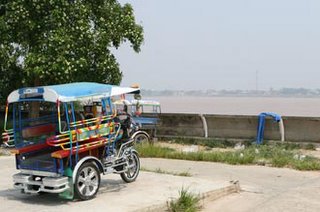
We decided to make an afternoon of it, taking one of the local tuk tuk’s (a three-wheeled motorcycle with a small compartment on the back in which to transport tiny Thai people and not fat Farangs) to Chum Phae. Once there, we got off and paid the guy a measly 20 baht (about 50 cents) for the two of us. I stopped at the bank and got hold of some money, as my wallet was running dry and Mam stopped in to the Western Union bank to pick up a check that her sister Gai sends on a regular basis from Bangkok. We then proceeded to walk about town, window-shopping and finally stopping to grab another tuk tuk for the long trek to Pizza Hut.
Well, we finally arrived at the local “Pizza Hut,” which wasn’t a Pizza Hut at all, but just a local Pizza joint. Disappointment almost set in, before I caught a whiff of cholesterol in the air, and like a zombie, gravitated to the front door. The experience was a good one. The pizza and chicken wings were Ahloeh mak, or “delicious,” even though it wasn’t my favorite Pizza Hut pizza. Typical for a Thai based, Western style restaurant, some of the pizza selections on the menu offered more familiar Thai toppings that I quickly passed up, but they were flexible and allowed me to design my own, custom pizza to my liking. I’m a traditional pizza die hard, brought up on pepperoni, black olives, jalapeno peppers, pork, onion, green peppers, bacon, occasional anchovy, and various cheeses, to name a few, whilst the slightest hint of pineapple on my pizza totally grosses me out. Mam was semi-horrified at the bill, as I forked over about 600 baht (about $15.00 U.S.) for the meal. Let’s face it; Western food is expensive here in Thailand, no matter how you slice it up.
Once satiated, I waddled outside into the hot, humid Thailand atmosphere and quickly wished I hadn’t eaten so much. We managed to actually take a little doggie bag home, much to the delight of Maak and Miuw, Mam’s two teenage children.
About three or four days later, we found ourselves traveling into Chum Phae again, with Boot, Paan, Miuw and Aye (Paan’s little ten year old grand daughter and a personal fan of mine) in tow, to purchase a little toy car for Paan’s grandson, Sky (another fan of mine). We finally found a large department store in town that sold bicycles, toys and the like, and was owned and operated by a large Hindu Indian family. It was odd to see these people, dark skinned and adorned with red dots on their foreheads in a small, Northwestern Thai city. The men wore huge silk turbans, while the women paraded around in long, flowing silk dresses with head covers and ornate earring piercing chained to their nostrils.
We eventually decided on a small plastic toy car with flashy decals, working steering wheel and shifter, complete with sound effects. While leaving the store, somebody mentioned something about being hungry and my mind started to work.
PIZZA!
I pleaded with Mam to take us all to the local pizza shop, thinking it would be a marvelous idea for these die-hard villagers to get a taste of the good life.
Well, I wasn’t totally wrong, but it seemed my idea fell quite a bit short of its intentional mark. Boot, a true village die-hard raised on weird Isaan food, nibbled at her pizza and merely pushed the food around on her plate. Paan was at least a bit more inventive, seeming to arrange the food on her plate to appear as though she actually ate it. Aye, being a true kid at heart, scraped all the pizza contents off the crust and picked at the items she wanted, leaving a huge pile of cheese behind. It was only Miuw (Mam’s 12 year old daughter), Mam and I, who finished off our pizzas.
Lesson learned…you can take the villagers out of the village but you can’t take the village out of the villagers!
In the remaining days of my stay, Mam and I continued out walks and one day ventured down a road we had yet to explore. Although Mam knew the way, we had walked a good distance when she suddenly decided we had walked far enough and wanted to turn around.
“Ah Mam,” I said, giving her my best pouting look. “Let’s just go around this corner ahead and then we’ll turn back. You never know, we may find something really beautiful.”
Being that Mam can’t seem to resist my pout, she acquiesced and we forged forward. Rounding the bend we were faced with a fork in the road ahead, where we decided we would turn around. As we approached the fork, Mam suddenly shouted out, “Look!” and following her pointed finger, I saw what is easily one of the most beautiful sights I’ve ever seen (for a plant lover that is…). Mam was pointing to the side of the road to our right, at several wild “Tiger orchids” as I would call them, which were growing along the side of the road.
Unfortunately I don’t have a camera, so I can’t show you the beauty of this huge, colorful flower, but suffice it to say that it was regal in appearance and shape and sort of takes your breath away when you see it. The flower itself is maybe three inches in circumference and bright orange, red and white striped, with an interesting stripe pattern. It is sustained on a long; one and a half to two foot stem with thick green leaves and is a rhizome-based plant.
Mam began to excitedly dance around saying, “We have dig up!” I concurred, but had no idea that this exercise was meant for me. She soon discovered a cut section of bamboo with a sharp end, lying on the ground, which had been discarded by someone. Excitedly, she pushed this crude tool into my hands and said, “You get!” while I looked at her in a troubled manner, hoping she would change her mind.
Although the bamboo “tool” was crude to say the least, it worked. But, this exotic beauty we were after hadn’t reached its healthy state by rooting over night. It turned out to be deeply entrenched in the hard earth and it took me nearly half an hour to free its tuberculate root, without killing the plant. Once we freed the plant, Mam and I (the latter covered in sweat from my half hour of toiling in the hot morning sun) sought out a discarded bag and placed the beautiful wild orchid in it, eventually filling the bag with water fetched from a nearby farm pond.
Miraculously we managed to get it home without incident and Mam’s mother, pleased as a pea in a pod, planted it in her flower garden. Mam and I have not forgotten about this spot where we discovered the wild orchid and we plan to someday return and score one for our own. Orchids grow easily in Thailand’s humid, Southeast Asian climate, and although we have a couple of varieties here at our home, our wish is to someday create a small garden of different varieties.
To add to our flower harvesting walks, Mam and I also discovered some small, white, wild woodland flowers during our daily morning walks and these too, became hardy specimens for her mother’s garden. Every trip was like a horticulturist’s dream for me, since I had never seen many of the species of flowers and plants growing wild along the road. I asked many questions of Mam, during our walks, and she often became frustrated, not being able to translate the meaning to me in English.
Several times during our walks, I had noticed long, straw covered mounds on the side of the road and asked Mam to explain. She couldn’t, but on one of our last mornings walking, we noticed several cars on the side of the road near one of these “mounds.”
As it turned out, these long, straw covered mounds were mushroom gardens! The people in the cars were harvesting them, taking the straw off the top of the mound to expose the rich, humid earth below, studded with white edible mushrooms that were to be sold at the local market. The “mushroom farmers” prepare an elongated “bed” of rich compost, seed the compost with locally purchased spores, place bamboo slats in an arc, at regular intervals over the compost bed, and cover the whole shebang with plastic and straw, creating a perfect, humid environment for the mushrooms to grow.
Good, hot weather, occasional watering, and patience will eventually reveal a harvest of plump, edible mushrooms ready for the market. I was constantly amazed at the numerous simple methods the local villagers used, to come up with marketable ideas that earned them money. This interested me, since I am fully aware that my resources of teaching will run out eventually, when I get to the age that I cannot teach on a regular basis. So, I’m confident Mam and I can turn our resources to the soil, of which individuals have been profiting for ages.
As an older man living in a foreign country, without means for income besides my present marketable qualities of being a native English speaker, I am naturally on the lookout for other means of sustainability when my present means runs out.
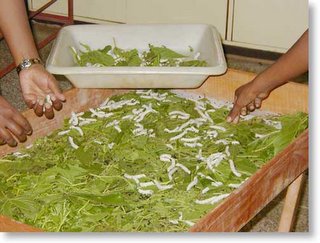
On yet another visit to one of Mam’s friends, who live out in the boonies, we were ushered to a dark corner of an outside stall, to see yet another resource of income for local villagers so inclined. The dark corner was filled with tiers of “racks” all of which were removable and contained vegetative material. Upon closer inspection, Mam and I saw thousands of squirming, fat white worms undulating about the surface. Silkworms, in fact, which were not only edible it seems, but also used for the local production of silk fabric.
Shades of my earlier years in history class, where I vaguely remember learning about the silk manufacturing process…
After the “worm” experience, we were guided to the cricket cages. Yes, I said, “cricket.” And no, I am not talking about the test match against Africa and Southern England.
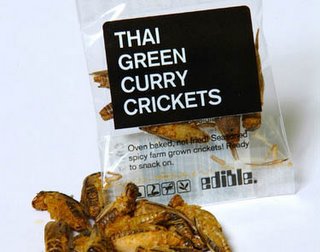
Crickets, as such, are a local delicacy it seems, where they are raised, pampered, and grown into monstrous sizes and then cooked over an open fire and unceremoniously eaten, as a wonderful source of protein.
On one our excursions to the huge market in Chum Phae, Mam and I picked up a “peck” of cooked crickets for the consumption of her mother, who apparently loves the six legged creatures. I was totally grossed out by this benevolent deed, but somehow managed to keep my cookies in order and not throw them up in violent protest.
Once we arrived home, we put away our groceries and settled into our usual, daily lazy lifestyle of lying about and waiting, seemingly for nothing. In the heat of the day, lying in the hammocks that surrounded the Kleh, one ends up pondering the meaning of life, if not other, less urbane subjects.
That particular day I did not choose to sit at the Kleh, but chose to reside at one of Mam’s other outside tables made of concrete. I wasn’t there long, before Boot, the oowan (Fat) lady who sells local lottery tickets, came and joined me. While sitting there, Mam approached us and brought out a small dish of fried crickets, which she plopped down unceremoniously, and said, “Enjoy!”
Well, unlike Boot, I DO NOT like bugs, nor do I like eating them. Boot, however, quickly pounced upon the six-legged treats and devoured several of them, much to my dissatisfaction and disgust.
Protein sources may be lacking with some Thai families, and it is fully understandable as to some of the bizarre means these individuals have of acquiring the proper nourishment, but I choose to stick to my Western habits and favorites, thank you.
The time for Mam and I to travel south was a sad one to say the least. As the local villagers prepared to see Mam go, they arrived in large numbers, offering pukaan, which is a local custom, involving placing a small string, often a braided one, around the wrist of the departing couple, in a ceremonious manner. Mam and I, by the last day, had so many of these strings tied around our wrists that we looked ridiculous, or so I thought.
At one point, Mam turned to me and said, “If we get married, you will receive pukaan (strings) so many times they will cover your forearm.”
On the evening of our last day in Chum Phae, without warning a huge crowd of people began to assemble, as Mam, Miuw, her mother, and numerous women from the village took control over the kitchen and produced a startling amount of food, from an incredibly small supply of food. Furniture was moved about to accommodate the large amount of people who showed up, and straw mats were laid down for the large groups. Once finished, the scene was one of a massive feast, people dotting the mats, and individuals singing, eating and generally enjoying the festive atmosphere.
Our last day spent in Chum Phae was a fairly quiet one, by my standards, where I “hid” upstairs and read my novel while slowly packing my things, as Mam repeated the same, filling her suitcase with as many items as she found necessary, as well as items of remembrance.
Again, seemingly on a whim, Mam told me we had to go to the temple and make do, with what was necessary for a goodbye. We traveled by truck, to an isolated area in the village, and once parked, walked to a distant area compound, which housed a sacred Buddhist “Joss-house” where she prayed and made offerings to the Gods. After a while Mam began to explore around the back of the building and when I asked what she was doing, she indicated she was looking for a “souvenir” which turned out to be a clump of dirt.
Mam still carries this clump of dirt in her purse, encased in a small plastic bag, her little piece of Chum Phae, which brings her luck and keeps her close to her birthplace. Life with Mam is enriching and I’m happy. She communicates to her friends and family on a regular basis and treats me like a king. We send money home to her mother and children every month, and Mam sees this as one of her many reasons to treat me in such a good way.
Our relationship is far from the conventional Western relationship, and it is often what many men in the West would describe as, living the perfect life. I insist that Mam doesn’t work, so she occupies her time at home by cleaning, shopping, cooking and generally taking care of the household. Every day before work, she polishes and shines my shoes, sets them out and escorts me to the front gate, handing me my umbrella and giving me a kiss goodbye.
In the afternoon, when I’m finished teaching, Mam is sitting across the street in the park, waiting to walk me home. We’re rarely apart, and we hold hands when walking together. Mam has had to endure being the brunt of all the local gossip, as the local Thai’s whisper about her being married to the Farang, but she stands strong and proudly holds my hand as we course through the village.
My mother once said to me, “Jimmy, if you ever get the opportunity when you grow up, marry an Asian woman, as she’ll take very good care of you and be a good wife to you.”
I wish she could see me now…
-Jeeem-